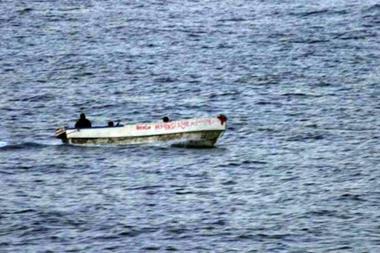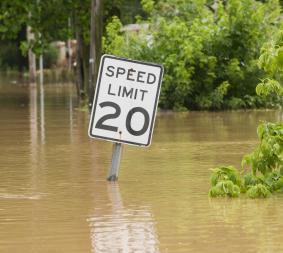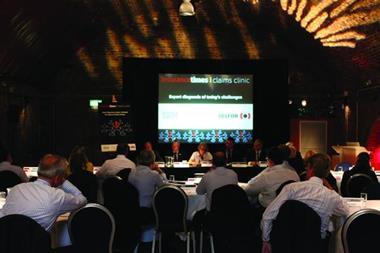Three US Court of Appeals cases could open the floodgates to mass tort claims and immense liability, by holding greenhouse gas-spewing corporations responsible for climate change damage. Could insurers be facing the 'new asbestos'?
Take some villagers from a remote Alaskan village, a collection of US state attorney-generals and lastly, property owners hit by Hurricane Katrina on the Gulf of the Mississippi. All live thousands of miles apart and all are facing different problems. But they have one thing in common: they are making legal history in the USA by suing corporations for accelerating the effects of climate change.
As the three cases wind their way through the US Court of Appeals, it is widely expected that one or more will reach the summit of the Supreme Court, and potentially force a groundbreaking ruling on climate change litigation.
Previously, climate change lawsuits have usually been submitted under federal environmental statutes, with a view to pushing the government to change policy or introduce new regulations. But now, these cases are heralding the emergence of mass tort litigation suits: civil actions involving numerous plaintiffs against one or a few corporate defendants.
Many believe that climate change suits are now primed to follow a similar trail set by past tobacco and asbestos cases – and could create a huge liability exposure for insurers and reinsurers.
Changing tide of litigation
The stakes were raised on 21 September 2009, when a court reversed a 2005 decision in Connecticut v American Electric Power Company, allowing eight states, New York City and three land trusts to proceed with their suit against various electric power companies. The plaintiffs claim that greenhouse gas emissions from the defendant’s fossil fuel-fired operations constituted a ‘public nuisance’. They are now in a position to persuade a court to create an injunction forcing each company to cap its carbon dioxide emissions by a specified percentage each year for the next decade.
Nine days after this, however, the district court of California reached a different decision when it dismissed a claim described by one lobby group as the “most dangerous litigation in America”. The villagers of the Alaskan village of Kivalina held that the loss of the Arctic sea ice shielding the village from winter storms could be traced to the carbon emissions created by energy companies including ExxonMobil.
This, they argue, has also accelerated the erosion of the coastline, leaving the village uninhabitable. They are claiming relocation costs of up to $400m.
But on 16 October 2009, there was one more twist as a New Orleans court revived another case. In Comer v Murphy Oil USA, a group of property owners along the Gulf of Mississippi filed a collective class action seeking damages in the wake of Hurricane Katrina. The court reversed an earlier decision barring Mississippi plaintiffs from pursuing a lawsuit against 147 oil, chemical and electric generation companies.
Plaintiffs claim the companies “unreasonably” and “intentionally” released a massive amount of greenhouse gases, causing the sea level to rise and increasing the strength of the hurricane. This resulted in the destruction of their property and they are therefore seeking compensation.
The Comer case is now scheduled for a review and the Kivalina plaintiffs are planning to appeal. Climate change law expert and Van Ness Feldman lawyer Kyle Danish believes that the ‘split’ in the Court of Appeals means it is likely the Supreme Court will have to weigh in.
Danish points out that, while the various plaintiffs have different goals, the same premise applies in all. “Each of these cases involves a tort-style claim that the actions of the defendants are creating climate change damage injury and that their continued actions will create even further risk of climate change damage.”
If the Supreme Court agrees with one or more of the plaintiffs and allows the claim to go to trial, it will be a major breakthrough in climate change litigation. Professor at the University of Houston Law Centre and director of its Environment, Energy and Natural Resource Centre, Tracy Hester, says the plaintiffs have already made huge progress. “They have got a long way in terms of actually getting before a jury and getting a verdict but, frankly, having two court panels ruling that such a case can go to trial is in itself a significant victory for the plaintiffs and one that energy markets will be watching very closely.”
Polluter pays
Meanwhile, the insurance sector is aware of the sea change. “Up to a year ago, there had been no favourable decisions at all. Now there are a few decisions that are in part favourable,” Munich Re liability law and emerging risks expert Dr Ina Ebert says.
Fellow reinsurance giant Swiss Re believes that climate change liability claims are set to grow at a faster rate than asbestos-related claims. Lloyd’s is also primed for change. “We foresee an increasing possibility of attributing weather-related losses to man-made climate change factors,” Lloyd’s head of emerging risks Trevor Maynard says. “This opens up the possibility of courts assigning liability and compensation for claims of damage.”
If the cases are allowed to proceed to trial, this is expected to trigger a spate of climate change lawsuits and significant new costs for insurers. Although the prospect of plaintiffs securing a successful verdict may remain small, the costs of litigation, including legal expenses, securing evidence and hiring scientists, will be substantial.
“It may take years to know that a case is not successful, and it can cost millions to know this,” Ebert says. Indeed, even if many cases fail, the door will be left wide open for a future law suit to succeed.
And what happens then? Chadbourne & Parke partner Mary T Yelenick points out that if a claim like the Comer case, which holds a company liable for causing a hurricane, achieves a favourable verdict, the liability exposure will be massive.
“In New Orleans, they are claiming the hurricane was of a greater force and ferocity because of greenhouse gases, so they are claiming damage to their homes, their workplaces, the value of their businesses – there is no end,” Yelenick says. “If you start giving away damages for that, there really is tremendous potential liability … The damages will be quite extensive – billions of dollars.”
But the three cases face substantial hurdles before they get to trial. First, there is the question of whether climate change suits have the legal ‘standing’ to be heard in the US. Up to now, the US courts have regarded climate change as a political question that should be dealt with by the political sphere rather than the judiciary. The argument holds that while courts can determine whether a company has breached a duty of care in a tort case, pinpointing the source of a global problem that has developed over a long period is beyond its remit.
This argument was upheld in the Kivalina case but overturned in Comer v Murphy Oil and Connecticut v American Electrical Power. Yelenick now describes the situation as a “tug of war” between the opposing parties about where climate change suits really belong.
The next stumbling block for the plaintiffs is the issue of causation. Ebert argues that even if courts accept that man-made climate change has occurred, linking specific damage to a single polluter is not yet scientifically possible.
“Any approach that would overcome the causation issues connected with climate change litigation would have to be so radical and far-reaching that it seems unlikely any court would ever be willing to go down that route,” he says.
Yelenick echoes the daunting challenge faced by the plaintiff representatives. “How can you establish that the greenhouse gases emitted by the defendants are responsible for causing damage when greenhouse gases are emitted by virtually everybody in society? These cases have selected only a few industries or defendants.”
To deny and deceive
Instead, Ebert predicts a shift towards claims based on non-compliance with regulations, such as a failure to warn or inform the public, or on conspiracy counts, where companies are accused of deliberating misleading the public, legislation and the courts. They could also be held liable for promoting scientific reports denying global warming or false claims of climate friendliness.
Indeed, the Kivalina suit did allege that electric power companies conspired to mislead the public about the dangers of global warming. While the viability of these claims was not addressed by the court, many believe it is only a matter of time before a similar conspiracy claim succeeds in holding a company liable.
Environmental lawyer Matt Pawa, who represents plaintiffs in the Kivalina and Connecticut suits, alleges there is a “long paper trail of their deception and denial of the problem and mis-stating of the scientific problem and hiring of sceptics”.
He draws comparisons with law suits against the tobacco industry. “There is a similar corporate story, in terms of exposing people to something very harmful and denying it.”
Pawa argues that the obstacles in direct liability claims can be overcome, predicting the emergence of “trillions of dollars of tort claims” for injuries caused by global warming.
He describes the political question doctrine as a barrier that has already been broken.
Indeed in 2007, the Supreme Court ruled in Massachusetts v Environmental Protection Agency that 12 states and several cities could sue the EPA in the courts instead of the traditional route of Congress, and force it to regulate carbon dioxide as an air pollutant.
“The whole political question thing is a red herring, and it has taken several years to straighten out,” Pawa says. “The district judge in the Kivalina case made a mistake. The political question doctrine does not fit here. With global warming, there are injured persons that need compensation and you have injured parties that need relief – that is what the courts deal with every day.”
Moreover, he is dismissive of the ‘causation’ argument, pointing out that the USA has a long history of holding subsets of polluters liable for contributing to damage or injury. “You don’t have to cause the entire problem – you can contribute.”
Plaintiff representatives also argue that, as climate change science develops, it will become easier to trace specific damage to specific polluters.
“There are certain companies in the USA that own a huge number of power plants that use a huge amount of emissions,” Pawa says. “There is a surprising degree of responsibility for the global warming problem in the hands of a relatively small group of companies. You are talking about a handful of companies that dominate the US emissions problem.”
Pawa confidently predicts that, within five years, plaintiffs will secure a favourable verdict, holding a company directly liable for climate change injury.
The road is long
Elsewhere, opinion remains divided about the outcome of any Supreme Court ruling. Yelenick anticipates the traditionally conservative court will adhere to the political question doctrine and dismiss the cases from the judiciary.
But Hester points out that while the plaintiffs “have a difficult road ahead”, the Supreme Court surprised many with its 2007 Massachusetts v EPA ruling.
And there is the possibility that the Supreme Court may have difficulty reaching a unanimous decision. “We have seen many spilt decisions in the Supreme Court in recent years, and it is hard to predict how this will go,” Danish says.
Further, it is possible that the clamour surrounding climate change litigation could force the US Congress to finally wade in and enact legislation on climate change – an action that would be welcomed by the insurance sector.
“To date, no comprehensive climate change legislation has been enacted in the USA. This ambiguity leads to uncertainty in the allocation of climate change liability, leaving insurers open to unexpected decisions in the legislature, regulation and litigation,” Maynard explains.
But again, there’s a ‘but’. Hester points out there is much “arm-wrestling” in Congress over whether any such legislation should bar climate change law suits. If any resultant legislation sidesteps this issue, it could give the go-ahead for much more litigation.
‘It could go either way’ seems to be the most common phrase evoked by industry observers when talking about the future of climate change law suits. Ultimately, its course has come to resemble a board game, as it twists and turns through the US judiciary, and leaving most with little clue of who will get the last throw of the dice. IT
Hosted by comedian and actor Tom Allen, 34 Gold, 23 Silver and 22 Bronze awards were handed out across an amazing 34 categories recognising brilliance and innovation right across the breadth of UK general insurance.














































No comments yet